Traditional Maltese Balconies
 Traditional balconies certainly go a long way in defining the character of the Maltese urban landscape. Through their abundance of colours, materials, textures and decorative motifs, they enrich the visual aspect of Malta’s streets. Projecting into the urban space, they dominate and articulate it.
Traditional balconies certainly go a long way in defining the character of the Maltese urban landscape. Through their abundance of colours, materials, textures and decorative motifs, they enrich the visual aspect of Malta’s streets. Projecting into the urban space, they dominate and articulate it.
When touched by the strong light so typical of the Mediterranean region they cast deep shadows on large expanses of plain stone walls creating a dynamic chiaro-scuro effect. Much like hanging gardens, the multitude of floral and foliage motifs in stone, wood and iron enliven both grand avenues and shady alleys. Further more, these static gardens are alive with beasts such as lions and horses, angelic figures and contorted faces.
 Due to their often sizeable proportions balconies also play a significant role as epitomies of architectural styles prevailing during particular periods. Balconies often constitute the main component of a facade and have a prime role in defining the architectural hierarchy both within a building and between different buildings. The largest, and most lavishly decorated, are usually those of the Piano Nobile of palazzos.
Due to their often sizeable proportions balconies also play a significant role as epitomies of architectural styles prevailing during particular periods. Balconies often constitute the main component of a facade and have a prime role in defining the architectural hierarchy both within a building and between different buildings. The largest, and most lavishly decorated, are usually those of the Piano Nobile of palazzos.
 As might be expected, architectural trends, including the use of balconies were first manifest in the city of Valletta. This occurred in the last quarter of the 17th century as a result of the increasing influence of the baroque movement, of which the balcony was a favourite device, in Europe. This latter expanded to the old city of Mdina and the Cottonera area and finally came to the villages during the 18th Century. For many years balconies also assumed important sociological roles, particularly by determining difference in classes. A balcony could define in no uncertain terms the social standing of the owner of a house or palazzo, with the more affluent turning them into their most noticeable public statements of status. On the other hand they also brought together rulers and ruled as was the case with Grand Masters who, after their elections, encountered their subjects from the palace balcony and showered them with coins in a gesture that was supposed to signify the beginning of a new era of prosperity.
As might be expected, architectural trends, including the use of balconies were first manifest in the city of Valletta. This occurred in the last quarter of the 17th century as a result of the increasing influence of the baroque movement, of which the balcony was a favourite device, in Europe. This latter expanded to the old city of Mdina and the Cottonera area and finally came to the villages during the 18th Century. For many years balconies also assumed important sociological roles, particularly by determining difference in classes. A balcony could define in no uncertain terms the social standing of the owner of a house or palazzo, with the more affluent turning them into their most noticeable public statements of status. On the other hand they also brought together rulers and ruled as was the case with Grand Masters who, after their elections, encountered their subjects from the palace balcony and showered them with coins in a gesture that was supposed to signify the beginning of a new era of prosperity.
To this day, balconies are still very much part of the Maltese way of life. They are the medium through which religious and parochial fervour are expressed. During religious feast days they are adorned with drapes, lights and effigies of saints. On a more practical level they serve as climate controllers and light providers. In older days it was often possible to see balconies hanging with a household’s drying washing. This practice is still alive in certain areas, particularly where large old houses have been subdivided and not all the residents have access to the roof.
Valletta Balconies
 In the case of Valletta, richly decorated balconies also served another purpose. One of the building regulations laid down by the knights for their new city was that blocks had to display some form of sculptural ornamentation at the corners. These ornamentations took three distinct forms. They were either niches with religious images, monumental pilaster and cornices that complimented the architectural style of the elevations or balconies that wrapped themselves around the block. Such balconies can be observed all around Valletta.
In the case of Valletta, richly decorated balconies also served another purpose. One of the building regulations laid down by the knights for their new city was that blocks had to display some form of sculptural ornamentation at the corners. These ornamentations took three distinct forms. They were either niches with religious images, monumental pilaster and cornices that complimented the architectural style of the elevations or balconies that wrapped themselves around the block. Such balconies can be observed all around Valletta.  Examples of these are the side wooden balconies of the Grand Master’s Palace, which were in place by 1741, and must be two of the earliest of this type, and the balcony of Palazzo Bonici completed in 1739 for Rev. Don Filippo Bonici. The palace was designed by Andrea Belli and is now part of the Manoel Theatre complex.
Examples of these are the side wooden balconies of the Grand Master’s Palace, which were in place by 1741, and must be two of the earliest of this type, and the balcony of Palazzo Bonici completed in 1739 for Rev. Don Filippo Bonici. The palace was designed by Andrea Belli and is now part of the Manoel Theatre complex.
Balcony Supports
 Two distinctive means were employed by architects to provide a masonry support for the base of balconies. This was done either by creating a masonry cushion along the length of the base or by inserting a number of stone brackets at right angles to the wall on which the balcony rested. These brackets often proved to be the most popular option. They are known as saljaturi and were often the object of lavish decoration. Strategic manipulation and distribution of such ornamentation was sometimes used to achieve an integral design between the different elements of the building’s elevation.
Two distinctive means were employed by architects to provide a masonry support for the base of balconies. This was done either by creating a masonry cushion along the length of the base or by inserting a number of stone brackets at right angles to the wall on which the balcony rested. These brackets often proved to be the most popular option. They are known as saljaturi and were often the object of lavish decoration. Strategic manipulation and distribution of such ornamentation was sometimes used to achieve an integral design between the different elements of the building’s elevation.
 An intriguing aspect of many saljaturi and stone cushion supports for balconies are the grotesque faces with disturbing expressions that are carved upon them. These are often menacing, almost repellent and wicked, bearing a tense expression at times verging on the burlesque. But to the people who commissioned them the presence of these masks on their facades was far from a laughing matter. With their furrowed foreheads and mostly their outstretched tongues, what might at first seem to be innocent if somewhat weird decorative motifs, were actually believed to ward off the evil eye. The believe that such masks could deter ill-meaning people from casting their evil spells dates back thousands of years and originated in classical times. The belief persisted through the middle ages and spread all across Europe.
An intriguing aspect of many saljaturi and stone cushion supports for balconies are the grotesque faces with disturbing expressions that are carved upon them. These are often menacing, almost repellent and wicked, bearing a tense expression at times verging on the burlesque. But to the people who commissioned them the presence of these masks on their facades was far from a laughing matter. With their furrowed foreheads and mostly their outstretched tongues, what might at first seem to be innocent if somewhat weird decorative motifs, were actually believed to ward off the evil eye. The believe that such masks could deter ill-meaning people from casting their evil spells dates back thousands of years and originated in classical times. The belief persisted through the middle ages and spread all across Europe.
There are no clear indications as to when this symbolism was introduced in Malta but its increasing appearance as an architectural element, particularly in relation to balconies, dates to the early 17th century and did not decline until the early 19th century. This is indicative since these were the years in which the Order of St. John implemented many of its building undertakings both institutionally and by individual members. These masks can be read as a manifestation of the common European culture of the multinational Order. This is somewhat anachronistic since the knights were a religious order. The Catholic Church, in fact, disapproved of the beliefe in the evil eye, and any other form of superstition come to that.
Political balconies
In the baroque era, architecture was a favourite means through which political statements were expressed in solid stone thus reflecting the totalitarian ideology of the time. It was a preferred medium through which political institutions projected their perceived power because of its immediacy and perpetuity. In some instances the choice of the decorative scheme for a balcony could be used to convey many messages more or less discreetly. This was an idiom that was understood and seriously considered by the intelligentsia of the time. Such is the case with one balcony in Mdina and another one in Valletta.
 The Balcony of the Mdina Law Courts overlooks Villegaignon Street. The building of the Law Courts was part of an urban regeneration project undertaken by Grand Master Manoel de Vilhena in 1722 following the havoc provoked by the earthquake of 1693. These included the building of a new Magisterial Palace to which the Corte Capitanale was annexed. Although the overall scheme was certainly designed by the French architect Charles Francois de Mondion, the Corte Capitanale facade, with its balcony section, shows also significant references to the style of the Italian Romano Fortunato Carapecchia although there are some who attribute it to Pietro Paolo Troisi who was appointed Master of the Mint of the Order in 1736.
The Balcony of the Mdina Law Courts overlooks Villegaignon Street. The building of the Law Courts was part of an urban regeneration project undertaken by Grand Master Manoel de Vilhena in 1722 following the havoc provoked by the earthquake of 1693. These included the building of a new Magisterial Palace to which the Corte Capitanale was annexed. Although the overall scheme was certainly designed by the French architect Charles Francois de Mondion, the Corte Capitanale facade, with its balcony section, shows also significant references to the style of the Italian Romano Fortunato Carapecchia although there are some who attribute it to Pietro Paolo Troisi who was appointed Master of the Mint of the Order in 1736.
This balcony is particularly interesting not only because of the high standard of the workmanship executed by the scalpellini (stone carvers) but also because it expresses the ideal of external ornamentation as an indication of the function of the building. In this case the administration of justice is inferred by the two allegorical figures of Mercy and Justice. The open stone balustrade balcony is reached by a door within a niche-like recess of classical flavour surrounded by a skilfully carved garland. This intersects over the arch of the door in an elaborate frame with a circular void in the centre. It is very probable that this space was meant to hold some sort of effigy, probably of de Vilhena, as is the case with the main portal of the adjacent Magisterial Palace. The Law Courts were completed in 1728.
A similar arrangement to the Corte Capitanale is found again at the Castellania, as the law courts of Valletta were known, in Merchants’ Street. This name derives from the title of the president of the courts who was known as Castellan. Grand Master Jean Levesque de la Cassiere erected the original building on this site, but Grand Master Pinto had this demolished and reconstructed in the baroque style that was so close to his heart. Work commenced in 1757 under architect Francesco Zerafa and was completed in 1760 by architect Giuseppe Bonnici.
 The main feature of the facade is obviously the portico surmounted by the balcony which is unique in Malta for its richness being completely made out of Carrara marble. The entrance to the balcony is through an elaborate door flanked by Corinthian pilasters and crowned with a broken pediment. As one’s view is guided upwards by the decorative programme one is overwhelmed by a sense of movement and grandeur that is wholly baroque. Resting over each side of the pediment are two allegorical figures holding their respective attributes. One is Justice holding a sword in her right hand and with a missing left arm that must have held a pair of scales. The other is Truth, which holds a mirror in her right hand and a serpent, or a morena, in her left hand. At the centre of this pediment rises a podium that supports a curved niche. At the base of this is a void plinth probably meant to hold a bust like the ones of the Auberges of Castile and Italy just up the road.
The main feature of the facade is obviously the portico surmounted by the balcony which is unique in Malta for its richness being completely made out of Carrara marble. The entrance to the balcony is through an elaborate door flanked by Corinthian pilasters and crowned with a broken pediment. As one’s view is guided upwards by the decorative programme one is overwhelmed by a sense of movement and grandeur that is wholly baroque. Resting over each side of the pediment are two allegorical figures holding their respective attributes. One is Justice holding a sword in her right hand and with a missing left arm that must have held a pair of scales. The other is Truth, which holds a mirror in her right hand and a serpent, or a morena, in her left hand. At the centre of this pediment rises a podium that supports a curved niche. At the base of this is a void plinth probably meant to hold a bust like the ones of the Auberges of Castile and Italy just up the road.
The whole finishes with a representation of an open curtain, a very baroque motif that was meant to create a stenographic backdrop to that infinite dramatic representation that is life itself. This reveals a representation of glory trumpeting the virtues of the Grand Master. At the centre is a missing element that most probably consisted of Pinto’s coat-of-arms. These were held by a putto still to be seen opposite the figure of glory. This later section is directly inspired, if not altogether copied, from the mausoleum of Grand Master Nicola Cottoner executed by Domenico Guidi and erected in 1686 in the chapel of Aragon in St. John’s.
The balcony arrangement at the Castellania, can be considered as a political, as well as an architectural, statement. Particularly so, if it had a bust of Pinto at the centre. This would in fact be a projection of Pintos image as a totalitarian prince who controls all the aspects of national administration, not least justice. This architectural element makes two statements. On the one hand, it aims at glorifying the figure of the Grand Master and commissioner of the work. On the other hand it is a direct reference to the earlier work commissioned by Grand Master Manuel de Vilhena in Mdina thus justifying the contemporary set-up through a historic president.
It is also an obvious attempt at outshining the earlier example. In fact here we see a profuse use of marble which, as said, is unparalleled in Malta even in buildings with more political significance such as the Grand Master’s Palace. In an organisation like the Order of Saint John rivalry was unavoidable. This occurred both at national and family level. Prestige was a matter of great importance and members of different Langues and households vied with each other to increase the lustre of their national group or family.
Types of balconies
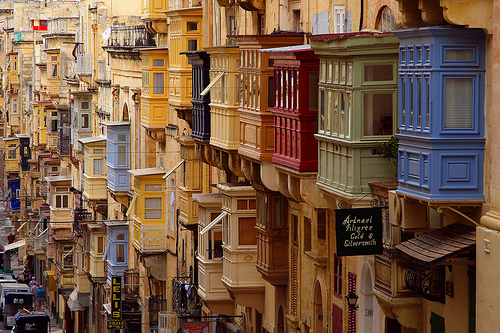 Although there are a great variety of designs and finishing details, Maltese traditional balconies can be broadly classified under two categories. These are the open type, which can either be in stone or wrought iron with more rare wooden ones, and then there is the more striking closed wooden balcony. Open stone balconies are the oldest type to be seen in Malta. They are most common in the older inhabited areas such as Mdina. This is a direct consequence of the Maltese environment which is poor in trees but abundant in deposits of soft, workable stone. Valletta also had its share of such balconies but many of these were later converted into closed wooden ones. The open stone balcony also has a long tradition in Gozo where the working of stone has always been a major craft. Many fine specimens can be seen on the sister island from very old to relatively recent examples.
Although there are a great variety of designs and finishing details, Maltese traditional balconies can be broadly classified under two categories. These are the open type, which can either be in stone or wrought iron with more rare wooden ones, and then there is the more striking closed wooden balcony. Open stone balconies are the oldest type to be seen in Malta. They are most common in the older inhabited areas such as Mdina. This is a direct consequence of the Maltese environment which is poor in trees but abundant in deposits of soft, workable stone. Valletta also had its share of such balconies but many of these were later converted into closed wooden ones. The open stone balcony also has a long tradition in Gozo where the working of stone has always been a major craft. Many fine specimens can be seen on the sister island from very old to relatively recent examples.
The Maltese Wooden Balcony
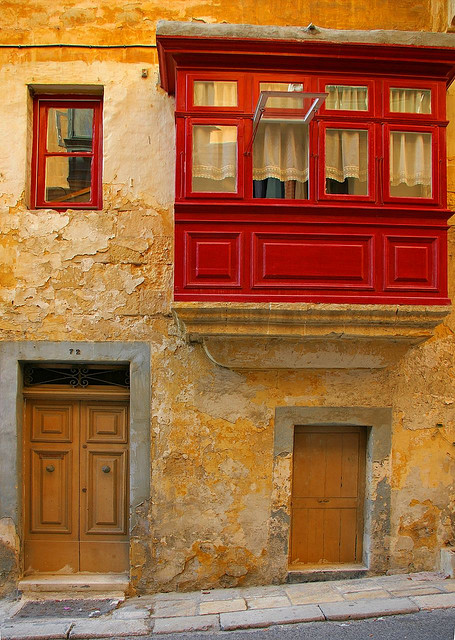 Small-scale wooden balconies started to appear in Valletta during the mid-eighteenth century and gradually gained popularity and became the fashion. This might have been influenced in no small way by the construction of the two grand wooden balconies of the Grand Master’s Palace referred to earlier. So universal was their spread that they eventually came to be referred to by the misleading name of La Maltijja (the Maltese) as if they were original to the place.
Small-scale wooden balconies started to appear in Valletta during the mid-eighteenth century and gradually gained popularity and became the fashion. This might have been influenced in no small way by the construction of the two grand wooden balconies of the Grand Master’s Palace referred to earlier. So universal was their spread that they eventually came to be referred to by the misleading name of La Maltijja (the Maltese) as if they were original to the place.
In reality this type of balcony was derived from North African, mostly Moroccan, prototypes which again derive from the Arabic Muxrabija (look-out place). During the rule of the Order, Malta was home to a huge number of predominantly Turkish slaves, some of whom were master craftsman who might have helped to introduce the wooden balcony to Malta.
Wooden balconies are mostly made of red deal (tal-ahmar). They used to be priced by purtella (window section) and often matched the main door. In the case of wrought iron ones these were made to match the grada (gate) that separated the main door from the street. But as an old saying puts it “the sun eats the wood while rain gives it drink”. Thus our climate is particularly stressful to these structures. The best traditional solution was always thought to be paint which gives the wood strength and oils.
 The British introduced a particular type of green that is slowly assuming the status of official colour for wooden balconies, particularly in Valletta. But traditionally, wooden balconies varied in colour like bright red, deep blue and exotic purple. Carpenters were the main craftsmen involved in their creation but blacksmiths were brought in for the various metal parts like gangetti (peg stays) and cappetti (hinges).
The British introduced a particular type of green that is slowly assuming the status of official colour for wooden balconies, particularly in Valletta. But traditionally, wooden balconies varied in colour like bright red, deep blue and exotic purple. Carpenters were the main craftsmen involved in their creation but blacksmiths were brought in for the various metal parts like gangetti (peg stays) and cappetti (hinges).
Contrary to another popular belief, it must be said that the wooden balcony became widely diffused in the British era, not the Orders’. This was due to the availability of timber, the consequent reduction in price and relative prosperity. Prior to the arrival of the British and their transformation of Malta into one of the main Mediterranean ports, timber was prohibitively expensive.
Naturally, when the new rulers made available the material to construct what, up till then, had been the prerogative of the earlier ruling class, the Maltese affluent class took the opportunity and decked their palazzos with closed wooden balconies. They were eventually followed by the other classes until the distribution become universal. Fine stone balconies made way to the new wooden counterparts.
The question of integrated design would be a preoccupation for many years to come. A sharp difference can be noted between purpose-built wooden balconies, which were part of the actual design of the building from its inception, and others that were added to an existing structure, often replacing a pre-existing stone one.
Due to the many employment possibilities and wealth generated by the British port activities, the Grand Harbour region faced an immense population influx in the early 19th century. This in turn created immense population pressure on a relatively small area and considerable sanitary problems ensued. Most of the tenements of the area were built between the 16th century and 17th century had very basic sanitary arrangements. The cholera epidemic of 1865 highlighted the problem in a dramatic way and hastened the implementation of a sanitary strategy. Valletta shared the same sanitary problems as many big European cities faced with the situations triggered by the Industrial Revolution and the exodus from the countryside to the city.
Water closets were one of the solutions but a whole infrastructure was required to sustain these. Many were installed either between recesses in double stone walls along staircases or in existing or purpose- built wooden balconies. Existing balconies had to be altered to serve this less noble architectural and human need. The side windows of the balcony, and a few adjacent ones, were rendered opaque by being painted over or were fitted with louvered shutters to afford a degree of privacy. In some instances the base was extended so as to accommodate the drainpipes that ran out of it and along the facades. Even the Palace balcony on Archbishop Street had a similar arrangement that was only removed in 1989. The situation only started to change drastically at the turn of the 20th century and took 50 years to reach acceptable standard. Until 1967 in Valletta there were still 183 buildings with a common lavatory for all the tenants.
A Heritage in Danger
As with so much of maltese heritage, balconies faced an extended period of decline through the wild urbanization period of the 1960s – 1990s that favoured other materials and styles. With the advent of enlightenment towards the beauty of traditional architectural elements in more recent years came the pillage of stone balconies, particularly in Gozo, from public facades to private gardens. But there is light at the end of the tunnel. Now regulations are in place to avoid a complete degeneration of village core urban characteristics and grants are being given to help owners with the considerable expense of restoring a wooden balcony. These measures should go a long way in helping to preserve our traditional gallariji.





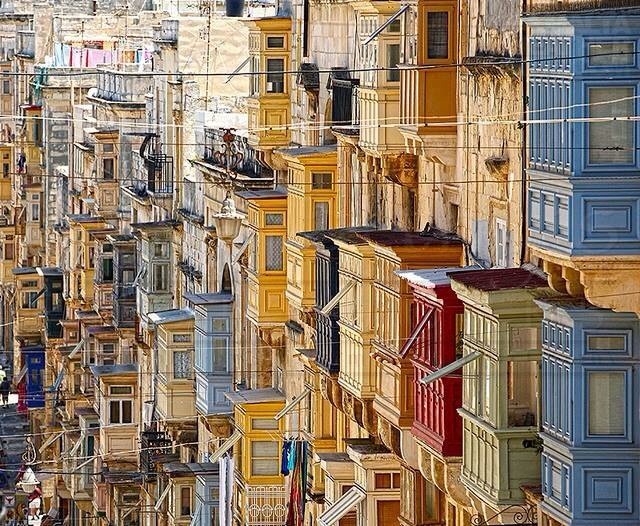
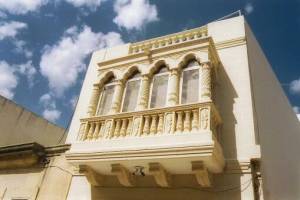






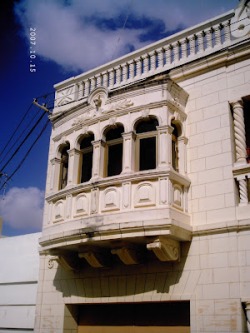
Out Malta tour guide told us that the wooden balconies were introduced by the Spanish conquerors (Aragonese kings) and were copied from the balconies left y the Moors in southern Spain (Andalucia) who had brought them from northern Africa y allowed for women in purdah to see the street life.